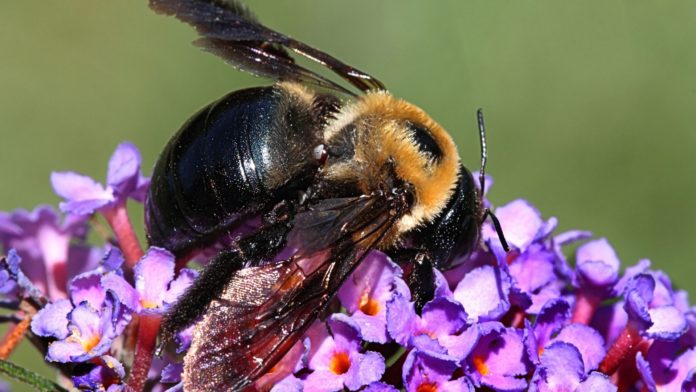Bees are a highly diverse and critical group of pollinators. There is evidence that beneficial and harmful microbiota may be regularly transmitted within and between bee species. Metagenomic analyses offer comprehensive insights into an organism’s microbiome, diet, and viral load but remain largely unapplied to wild bees.
In a new study, scientists from York University presented metagenomic data from three species of carpenter bees sampled around the globe. Using a combination of machine learning, co-occurrence, and network analyses, they found that wild bee metagenomes are unique to host species.
Furthermore, the study revealed that the local environment significantly impacts the health and variety of wild bees’ gut microbiome, which could aid in the detection of unseen stresses and early indicators of possible hazards.
Unlike social bees (like honeybees and bumblebees), solitary bees are found to get their microbiome from their environment, where they hunt for food instead of inheriting it from their nest mates. Carpenter bees burrow into woody plant stalks to lay eggs rather than in hives.
Faculty of Science Associate Professor Sandra Rehan, corresponding author of the research, said, “This may make them better bio-indicators as they are much more sensitive to their environment. Comparative metagenomics reveals expanded insights into intra- and interspecific variation among wild bee microbiomes.”
Local populations in Australia have unique metagenomes and microbiomes, where machine learning methods could consistently predict which population each bee came from.
Scientists could also detect crop pathogens in the microbiomes of carpenter bees. These pathogens were previously only found in honeybees.
Rehan said, “These pathogens are not necessarily harmful to bees, but these wild bees could potentially be vectoring diseases that might negatively affect agriculture. Finding out how these pathogens are spreading in wild bees is important as bees contribute to ecological and agricultural health worldwide and more than $200 billion in annual agricultural services.”
Scientists can compare species across continents and communities and figure out how diseases and harmful bacteria are introduced and transmitted by establishing a baseline of what a healthy microbiome looks like in wild bees.
Rehan said, “We can dissect bee health systematically by looking at population genetics and parasite pathogen loads, healthy microbiomes, and deviations. The long-term goal is really to be able to use these tools to be able also to detect early signatures of stress and habitats in need of restoration or conservation. To develop it almost like a diagnostic tool for bee health.”
According to scientists, this is the first time someone has mapped the core microbiome of carpenter bees. Beneficial bacteria are present in all three carpenter bee species that aid in metabolic and genetic functions. They also detected Lactobacillus species, an essential beneficial bacteria group imperative for good gut health and found across most bee lineages. Lactobacillus may protect against prevalent fungal pathogens, boost the immune system, and facilitate nutrient uptake.
Rihan said, “We’ve been piloting this research approach in a few species, but we’re aiming to study dozens of wild bee species, and broader comparisons are coming. These two studies establish the foundation. The long-term goal is really to be able to use these tools to detect early signatures of stress in wild bees and thereby identify habitats in need of restoration or preservation. We are excited to be building the tools for a new era of wild bee research and conservation.”
Journal Reference:
- Comparative metagenomics reveals expanded insights into intra- and interspecific variation two among wild bee microbiomes, Communications Biology (2022). DOI: 10.1038/s42003-022-03535-1
